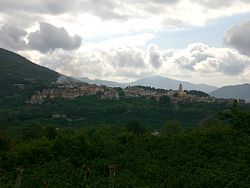Giffoni Sei Casali
| Giffoni Sei Casali | ||
|---|---|---|
| Comune | ||
| Comune di Giffoni Sei Casali | ||
 View of Capitignano, the municipal seat. | ||
| ||
 Giffoni Sei Casali within the Province of Salerno and Campania | ||
 Giffoni Sei Casali Location of Giffoni Sei Casali in Italy | ||
| Coordinates: 40°43′N 14°54′E / 40.717°N 14.900°E / 40.717; 14.900 | ||
| Country | Italy | |
| Region | Campania | |
| Province | Salerno (SA) | |
| Frazioni | Capitignano (municipal seat), Malche, Prepezzano, Sieti | |
| Government | ||
| • Mayor | Francesco Munno | |
| Area | ||
| • Total | 35.08 km2 (13.54 sq mi) | |
| Elevation | 250 m (820 ft) | |
| Population (28 February 2017)[1] | ||
| • Total | 5,213 | |
| • Density | 150/km2 (380/sq mi) | |
| Demonym(s) | Giffonesi | |
| Time zone | UTC+1 (CET) | |
| • Summer (DST) | UTC+2 (CEST) | |
| Postal code | 84090 | |
| Dialing code | 089 | |
| Website | Official website | |
Giffoni Sei Casali (Campanian: Jfun) is a town and comune in the province of Salerno in the Campania region of south-western Italy.
Contents
1 History
2 Geography
3 See also
4 References
5 External links
History
The communal seat, Capitignano, appeared when the Romans destroyed Picentia, whose inhabitants took refuge on the mountains nearby. The modern name, according to tradition, would derive from Caput Jani ("Janus' head"), referring to the head of statue of the god which they brought to the new site.
Capitignano was part of the Kingdom of Two Sicilies until 1860, as part of the district of Salerno.
Geography
The municipality is situated in a hill zone by the Picentini mountain range. It borders with the municipalities of Calvanico, Castiglione del Genovesi, Fisciano, Giffoni Valle Piana and San Cipriano Picentino.
Giffoni is divided into four frazioni, Capitignano being the administrative seat. The other are Malche, Prepezzano and Sieti.
See also
- Monti Picentini
- Giffoni Valle Piana
- Giffoni Film Festival
References
^ Population data from Istat
External links
![]() Media related to Giffoni Sei Casali at Wikimedia Commons
Media related to Giffoni Sei Casali at Wikimedia Commons
Official website (in Italian)
This Campanian location article is a stub. You can help Wikipedia by expanding it. |
